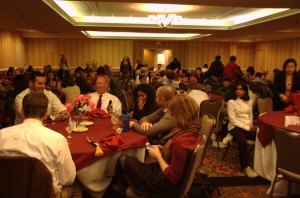As I had mentioned they would, a group of 150 9th graders from Charlotte’s Providence Day came to Raleigh today to learn about its Citizens Advisory Councils and to learn more about civic participation. As I expected, I loved every minute of it. I even called Kelly at lunch and gushed at how I was in my element.
I didn’t have a real agenda in front of me until this morning. That’s when I found out I would be leading the first hour of the discussion about what CACs are and what they do. I was wondering how I would fill up this hour but it turned out to be easier than I anticipated. We started quite a bit late and when asked to say a few words about how they became involved with CACs, some of the chairs on the panel talked at length about the whole CAC experience.
This wasn’t a bad thing, necessarily, but it wasn’t exactly what the students were there to hear. I had hoped we could answer more questions from the audience, or that I could get them to provide answers about ways CACs have proven useful. Instead the introductions alone caused us to run out of time. I asked Eric Hedgepath, the guy in charge of the trip, whether we could run a little longer but he said we had a hard stop at the original time. When that time arrived, the CAC discussion ended and the crowd took a snack break.
After the break, the kids split up into various meeting rooms. Each was given an issue to focus on, and groups were formed within those caucuses to represent actual Charlotte-area constituencies. I was amused when the kids representing Duke Energy began their moderated statements by championing the environment. As the caucus wore on, they had drifted back to protecting their turf, prompting some kids to complain how difficult it now had become to work with them.
I was invited to drift among the various rooms but soon settled on one at the end of the hall. I decided that I would gain more by watching the whole evolution of the discussion rather than drop in and out.
This was an exercise in parliamentary procedure. The speaker, teacher Hutch, at first had difficulty soliciting the kids to offer up resolutions. By the end of the exercise, however, the placards were flying up fast and furious. There were motions, motions on top of motions, friendly amendments, and just about anything else taking place. The group went back and forth on the question of how they would run their discussion: moderated or unmoderated. Votes were split, tension waxed and waned in the room, and finally with less than 10 minutes before lunch the group came up with a resolution they could agree on.
I offered comments as they went, praising how the kids representing a group advocating for lower taxes were always putting the discussion in terms of money. I stressed how almost all of the work on laws and ordinances takes place in committee, away from the lights and (most of) the public. I also explained how any proposal that gets pitched to the city council or other deliberative body winds up competing with many others for a slice of the budget. I tried to make a distinction between the more collegial debate at the local level and the more formal debate at the state level. Oh, and I kept having to remind Hutch not to declare a motion passed until he’d polled both yea and nay votes.
With their resolutions in hand and lunch in their bellies, the student groups made their presentations to the mock city council composed of CAC leaders and city councilors. Patrick Martin had departed after our morning session, leaving myself, Bill Padgett, Paul Brant, and Deborah Ford from the CAC side. Joining us was Councilor Thomas Crowder and Councilor Russ Stephenson. I offered the “mayor” job to Councilor Crowder who ran the meeting like a real council session.
The students did a find job of presenting. Some were visibly nervous while others seemed quite comfortable with their roles. All of the resolutions promoted goals that included admirable cooperation between their “constituency groups.” The one thing many seemed to be missing were details. A few student proposals included requests for “tax dollars” without specifying how much and how the money would be used. Some stumbled when a mock councilor would ask about a detail they hadn’t considered.
We didn’t get a chance to debrief the kids but one thing I hoped to share was the need to know what it is you’re asking for and to be able to immediately provide the answers to whatever questions you get. It’s a very important thing to be requesting public funds: you’d better be able to justify it.
Out of 9 resolutions the students made, I believe we approved six and sent the other three to committee to gather further details. Many hinged on data the mock council did not have available for the scenario, i.e. what our budget looked like, transportation data we had, etc. We winged it well, though, and by sending some back to committee we demonstrated what regularly happens at council sessions.
Councilor Crowder had to depart at exactly 2:30 and, as in a real city council session, he handed the gavel over to real-life Mayor Pro-Tem Stephenson after the council approved the motion. We heard the last two proposals before our time ran out. Then we got a round of applause from the students before they rushed out the door to board their buses home.
I have to say I was enjoying being called “Councilor Turner” during the mock session.
It was a wonderful opportunity to highlight Raleigh’s strong commitment to community involvement.
